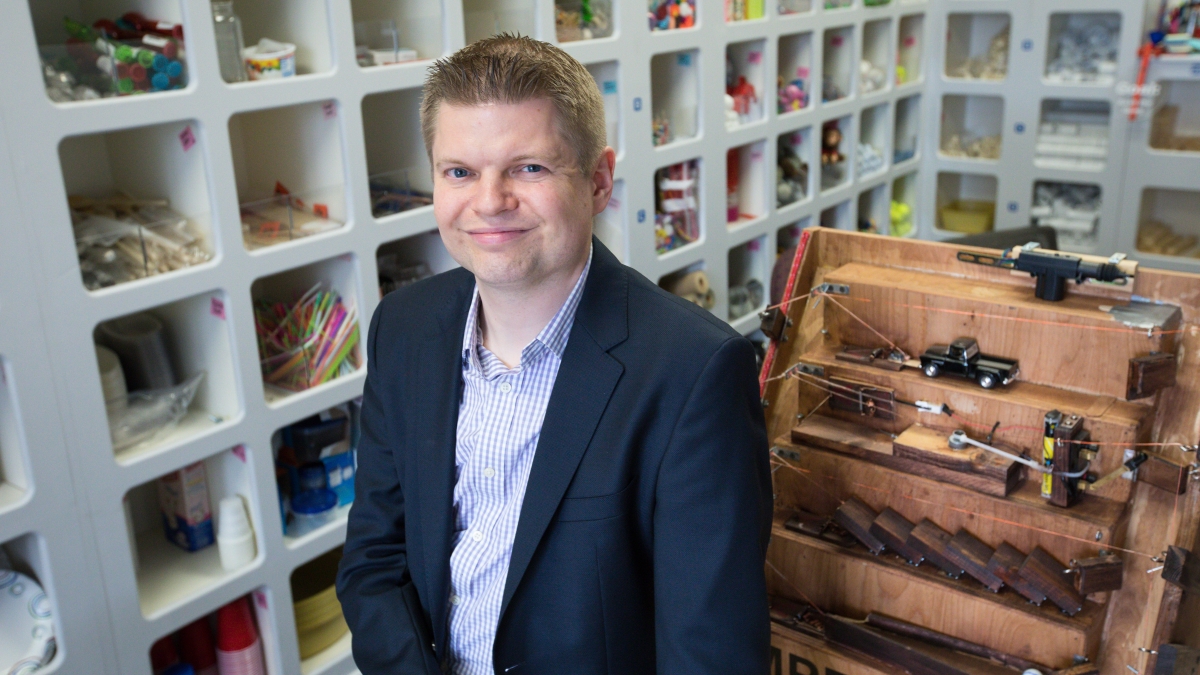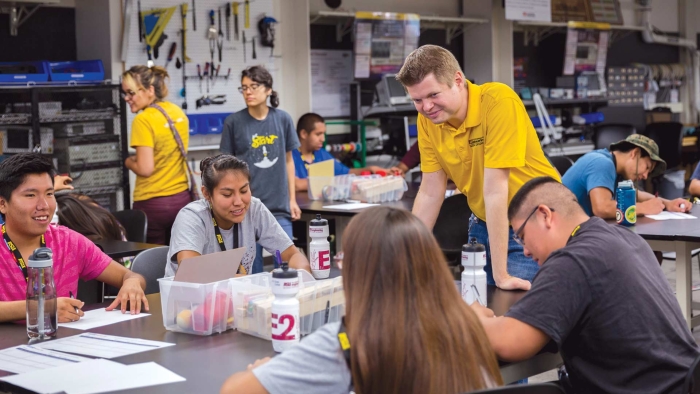Expanding engineering education across the career spectrum

Shawn Jordan, an ASU associate professor of engineering and interim director of the new School of Integrated Engineering, is pictured in his Science, Technology, Engineering, Arts and Math, or STEAM, Lab, which enables middle school and high school students and teachers throughout Arizona to get involved in classes, curriculum and educational camps focusing on integrating engineering knowledge and practices with other STEAM disciplines. Photo by Charlie Leight/ASU News
“It’s not just a job, it’s an adventure!” proclaimed a popular U.S. Navy recruiting advertisement more than four decades ago.
That sums up the mindset with which Shawn Jordan is stepping into the role of interim director of the newest school to become part of the Ira A. Fulton Schools of Engineering at Arizona State University.
At the helm of the School of Integrated Engineering, Jordan’s job won’t involve simply following a course already charted by the seven other Fulton Schools. It will be about breaking new ground.
Jordan is leading the charge to fuse today’s expanding engineering knowledge and practices into a broader spectrum of entrepreneurial and industry pursuits.
His role is to guide the establishment of the new school’s programs, which are designed to prepare students specifically for jobs and careers in evolving high-tech areas such as microelectronics. That task will also include developing curricula to arm students with engineering skills combined with other disciplines to excel in today’s increasingly competitive and demanding technology-based companies.
“What we want to create with this school is an evolutionary enterprise that breaks down traditional disciplinary boundaries,” says Jordan, an associate professor of engineering who for the past 13 years has been a faculty member in The Polytechnic School, part of the Fulton Schools.
Enhancing opportunities in the West Valley
The new school’s focus won’t be strictly on preparing students for conventional technology jobs. It will offer courses exploring the possibilities of adapting engineering skills, principles and practices to contribute to progress in many emerging career areas, such as business operations and management, nursing, fashion and teaching.
“The idea is to create new and forward-looking programs that will produce graduates able to uniquely define themselves as experts and innovators who can bring real value to a variety of business markets and to our overall economic and societal cultures,” Jordan says.
A key mission of the School of Integrated Engineering, headquartered on the ASU West Valley campus, will focus on serving the needs of the Phoenix area’s West Valley communities.
“The West Valley has been historically underserved when it comes to engineering. That’s one of the main reasons ASU wants to help bring engineering there,” Jordan says. “We want to open doors for current and future students who want to study engineering closer to where they live. We want to connect with companies that are already in the area or may want to locate there in the future if many of their workers are living in and vested in the local community.”
Collaborating with local industry
Jordan foresees the new school boosting the overall prominence and impact of the ASU West Valley campus by opening opportunities to establish valuable industry partnerships.
“One of my big aspirations for the school is to establish diverse academic programs that reflect the needs of the community. A big part of doing that effectively requires having very active partnerships with a variety of companies,” he says.
Jordan envisions opportunities for collaboration that do more than provide internships and scholarships for students or provide companies with candidates for potential hires. Ideally, these productive collaborations will provide starting points for industry-academia enterprises that bring innovation to the melding of business and higher education pursuits, he says.
This approach to industry relationships also reflects Jordan’s goal to see the new school teach students not only the technical aspects of engineering but also make them aware of corporate and economic frameworks of the engineering industry, Jordan says.
Building on an expansive career
Jordan’s own career experience encompasses a range of the business, educational, technical and research aspects of the engineering profession.
He earned a bachelor’s degree in computer engineering, a master’s degree in electrical and computer engineering and a doctoral degree in engineering education from Purdue University.
He collaborates with communities to combine STEM subjects with arts and culture to create novel products, experiences and outcomes that meet societal needs. His past and present collaborations integrate STEM with storytelling, fashion, improv, music, theater, dance and kinetic arts in both K–12 and undergraduate settings.
Jordan also co-developed a Science, Technology, Engineering, Art, and Math, or STEAM, Labs program to help middle school and high school students integrate knowledge across disciplines to create unique solutions to various STEAM-related problems.
He has been the principal investigator for projects funded by the National Science Foundation (NSF) related to design, including several NSF-funded projects that studied the intersections of engineering design and Diné, or Navajo, culture, and he worked for a season on the PBS engineering design reality TV show “Design Squad.”
He has also won numerous engineering research and teaching awards for his research and teaching in engineering education, including a prestigious NSF Presidential Early Career Award for Scientists and Engineers for his work with Navajo youth.
Jordan is especially qualified to help lead the Fulton Schools in its ambitious efforts to expand academic and research endeavors, says Professor Kyle Squires, ASU’s senior vice provost of engineering, computing and technology and dean of the Fulton Schools.
“A key goal for the academic programs is attracting students to engineering who otherwise may not choose one of our majors,” Squires says. “The broad strategy is to combine engineering in novel ways with other disciplines, which will require new approaches to the designs of degree programs and curricula. All of this has already been a sharp focus of both Shawn’s teaching and research interests.”
Alan Cheville, a Bucknell University professor of electrical, computing and energy engineering, has collaborated successfully with Jordan on work with the Electrical and Computer Engineering Department Heads Association related to the Maker Movement, which encourages people to become creators of products and services rather than merely using them.
“I know Shawn also does a lot of cool stuff in the courses he teaches,” Cheville says. “He is also especially well-organized and detail-focused, so I think he will be really good as a school director.”
Ann McKenna, former director of The Polytechnic School and now dean of the University of Iowa College of Engineering, is one of Jordan’s longtime colleagues.
“Shawn’s passion and talent for developing and implementing innovative, engaging and student-centered curricula is clear,” McKenna says. “He has the unique ability to combine technical expertise with an open-ended, user-centered design approach, which enables students to creatively apply their engineering content knowledge to developing realistic, usable solutions,” she says.
McKenna points to Jordan’s creativity in exploring novel approaches such as storytelling and improv as a way for students to communicate effectively about the impact of their work.
“He has also worked extensively with the Navajo Nation in designing culturally relevant engineering pedagogy and has led several teacher training workshops to enable broad dissemination of his curricular materials,” McKenna says. “Shawn is a true engineering education innovator, and it’s fitting he will serve in a leadership role in the newest of the Fulton Schools.”
More Science and technology

ASU professor wins NIH Director’s New Innovator Award for research linking gene function to brain structure
Life experiences alter us in many ways, including how we act and our mental and physical health. What we go through can even change how our genes work, how the instructions coded into our DNA are…

ASU postdoctoral researcher leads initiative to support graduate student mental health
Olivia Davis had firsthand experience with anxiety and OCD before she entered grad school. Then, during the pandemic and as a result of the growing pressures of the graduate school environment, she…

ASU graduate student researching interplay between family dynamics, ADHD
The symptoms of attention deficit hyperactivity disorder (ADHD) — which include daydreaming, making careless mistakes or taking risks, having a hard time resisting temptation, difficulty getting…
